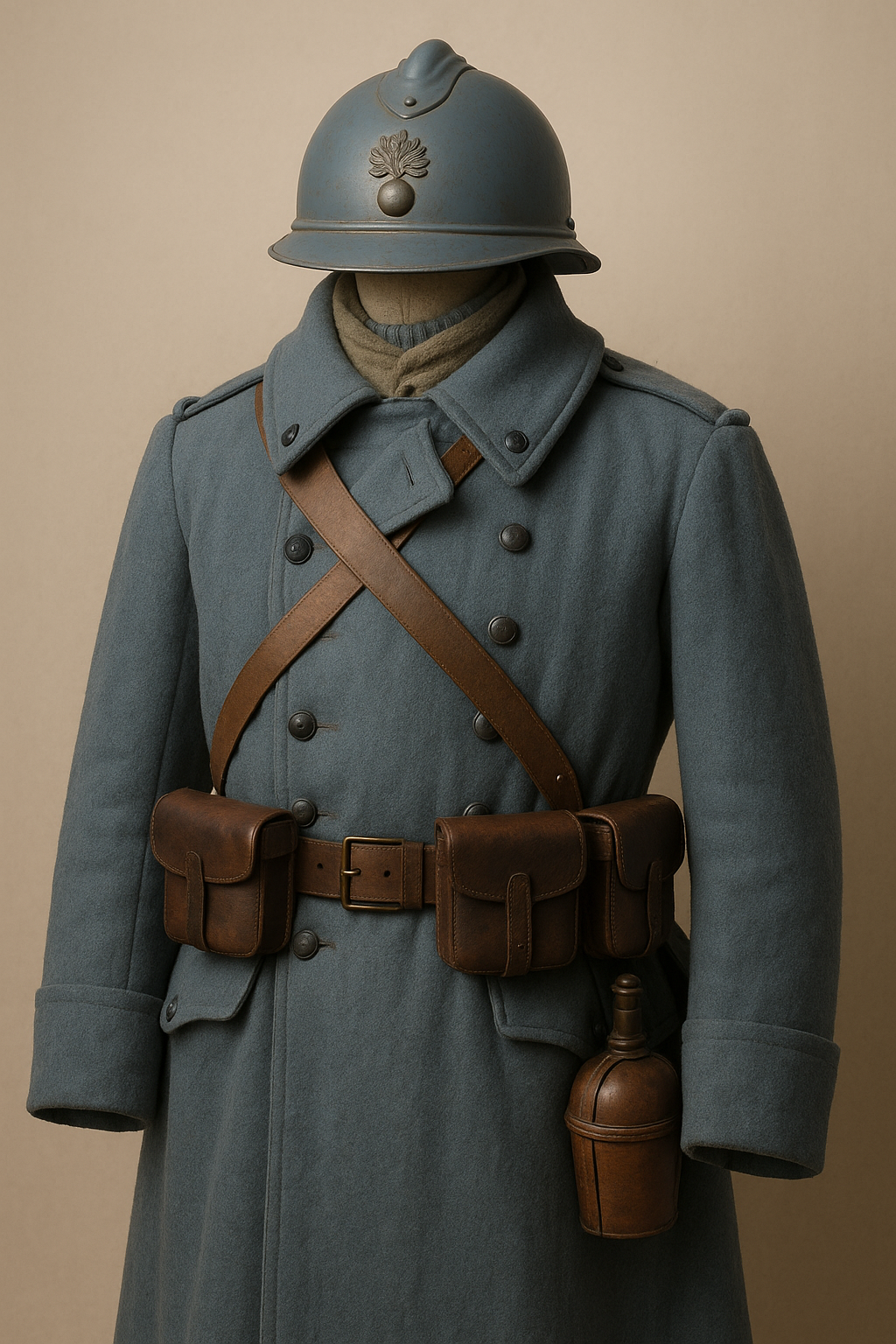
The Iconic WW1 French Uniform: History, Details, and What You Need to Know
Published on Sep 29, 2025
🪖 Introduction: Did You Know Over 1.3 Million French Soldiers Died in WW1?
The First World War was one of the deadliest conflicts in human history, and France paid a devastating price. Over 1.3 million French soldiers lost their lives, with millions more wounded. (Source: French Ministry of Armed Forces)
But beyond the trenches and bloodshed, WW1 also left behind some of the most iconic military uniforms in history. The WW1 French uniform—with its bold colors, thick greatcoats, and symbolic medals like the French Croix de Guerre with Palm—tells a story of resilience, evolution, and national identity.
Whether you're a military history enthusiast, a collector, a reenactor, or just curious, this guide will walk you through:
- The history and key components of WW1 French uniforms
- How to collect or identify authentic items
- Current trends and common pitfalls to avoid
Let’s dive in.
🧥 The Evolution of the WW1 French Uniform
From Bright Blue to Horizon Blue: A Lesson in Survival
When WW1 broke out in 1914, French soldiers (Poilus) wore bright red trousers and dark blue coats—a uniform that made them easy targets on the battlefield.
“They looked more like parade soldiers than front-line infantry,” said a British war correspondent in 1914.
Transition to Horizon Blue
By late 1915, the French army switched to a more practical color: “horizon blue”, a grayish-blue designed to camouflage soldiers in the trenches.
Key Components of the WW1 French Uniform:
- Adrian Helmet: Introduced in 1915, made of mild steel, and adorned with a regimental badge.
- Horizon Blue Greatcoat (Capote): Heavy wool, double-breasted, with large lapels—ideal for harsh trench conditions.
- Puttees and Leather Boots: Used for ankle support and protection.
- Lebel Rifle Equipment Pouches: Designed to carry ammo and tools.
💡 Tip for Collectors: Authentic greatcoats often have hand-stitched buttons, rough wool fabric, and shoulder epaulettes with regimental insignia.
🪖 WW1 French Greatcoat: Function Meets Fashion
The French WW1 greatcoat (Capote) is perhaps the most iconic piece of the French uniform. It was more than just a fashion statement—it was a survival tool.
Features of the French WW1 Greatcoat:
- Material: Thick, rough wool to resist cold and damp.
- Design: Double-breasted with six buttons and an adjustable belt.
- Color: Horizon blue, fading over time due to dye inconsistencies.
- Practicality: Large pockets and fold-back cuffs for functionality.
Modern Reenactors & Collectors love these for:
- Historical reenactments
- Static displays
- Cold-weather military cosplay
- Museum exhibitions
Common Pitfalls When Buying a WW1 French Greatcoat:
- ❌ Mistaking WW2 versions for WW1 (WW2 coats are often darker and have subtle design changes)
- ❌ Reproductions sold as originals
- ❌ Missing unit insignias or badges
Pro Tip: Use a blacklight to test fabric aging and look for period-authentic tags or stamps.
🪙 Medals & Honor: The French Croix de Guerre with Palm
Awarded to both French and Allied soldiers, the French Croix de Guerre with Palm is a powerful symbol of valor.
What It Means:
- Croix de Guerre: "War Cross" awarded for acts of heroism.
- With Palm: Denotes a mention in dispatches at the army level, the highest recognition.
If you find a uniform or jacket adorned with this medal, it’s a significant collector’s item—often increasing the item's value by 2x or more.
📊 French Casualties in WW1: The Human Cost Behind the Uniform
Understanding the human toll adds deep context to the history of the French WW1 uniform.
How Many French Soldiers Died in WW1?
- Killed: 1.3 million+
- Wounded: Over 4 million
- Civilian Casualties: 300,000+
That’s nearly 20% of the male population aged 20–40 in 1914.
Every button, bullet hole, and bloodstain tells the story of a man who likely faced unimaginable horrors.
Why This Matters for Collectors and Historians
- Items like trench-worn coats or bloodied armbands carry emotional and historical weight
- Provenance is essential—ask sellers about the item’s story
🧠 Actionable Tips: How to Start Your WW1 French Uniform Collection
Getting started doesn’t require a huge budget, but it does demand attention to detail.
Where to Begin:
- Start with a Reproduction Adrian Helmet – Affordable and iconic.
- Add a Horizon Blue Greatcoat – Original or high-quality repros are widely available.
- Look for Accessories – Ammo pouches, canteens, medals.
- Attend Militaria Shows – Great for networking and finding rare pieces.
- Join History Forums & Facebook Groups – “WW1 Militaria Collectors” is a popular choice.
What to Avoid:
- ❌ Overpaying for basic pieces
- ❌ Ignoring restoration signs (sewing repairs, replaced buttons)
- ❌ Buying without asking for clear provenance
🕵️ WW1 vs WW2 French Uniforms: What’s the Difference?
Collectors often confuse WW1 French uniforms with WW2 French uniforms, but there are key distinctions:
FeatureWW1 UniformWW2 Uniform
Color Horizon Blue, Olive green, or tan
Helmet Adrian with regimental badge, Modified Adrian, or Casque modèle 35
Greatcoat Design Longer with larger lapels Shorter, more utilitarian
Medal Arrangement: Often more prominently displayed, more standardized
Tip: If you’re buying online, ask for close-up photos of collars, linings, and buttons.
📈 Current Trends in WW1 French Uniform Collecting
What’s Hot Right Now:
- Trench Art: Shell casings, carved lighters
- Named Medals: With documents or a photo of the soldier
- High-Rank Officer Uniforms: With embroidered collars
- Croix de Guerre Variants: With palm, star, or oak leaves
Where to Find Authentic Pieces:
- French auction houses (like Drouot)
- eBay (filter by “France only” + “WW1 original”)
- Reputable militaria dealers
- Estate sales and family archives
🎯 Conclusion: Preserve the Past, Piece by Piece
The WW1 French uniform is more than just clothing—it’s a living history artifact, worn by millions of brave men in one of the darkest chapters of human history.
Whether you're in it for the love of history, reenactment, or collecting, always approach it with respect, curiosity, and caution.
